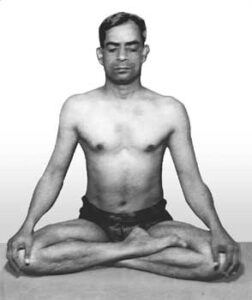What is the relationship between breath and meditation.
The breath goes past the septum. Behind the septum is the nasal cavity. The septum acts like a venturi, so when the air goes past it, it expands suddenly. Consequently, the air gets a swirl when it hits the roof of the nasal cavity, resulting in the following;
- There is a rushing sound generated by the swirling of air in the nasal cavity.
- The increased energy downstream of the flow of air results in an increased temperature of air when it enters the nasal cavity.
- Importantly, since the entrance to the auditory tube is also in this cavity, any change in pressure here will affect the pressure in the Eustachian tube – hearing and balance.
- Finally, all the senses of taste and food temperature are centred round the face.
Why is this important? The experience of breathing comes from the sound and sensation of breath going past the septum and the olfactory receptors which also transmit the sensation of smell. Similarly, all other senses are directly or indirectly associated with the breath and the quality of breathing. Therefore, control of breathing is essential for control of the senses.
When the suction pressure is equalised with the septum-nasal cavity pressure, then there is no sensation of breathing. This should be achieved and retained, even during activity. When we succeed in stopping either the outgoing or incoming breath, this state is called kevala-kumbhaka (only emptiness).
What does Hatha Yoga Pradeepika (Chapter 1, verse 10 – 16) says about dhyāna (meditation).
Hatha Yoga protects the yoga practitioner from pain like a house and supports his efforts like a tortoise. In fact, the yoga practitioner should keep the knowledge secret.
He should practice in a small room, situated in an isolated place, free from stones, fire and water or disturbances of any kind. Also the land should be governed in a dhārmic manner. This means that all citizens must conform to the rule of law and live in harmony.
Also, the room should have a small door, level, be free from holes and hollows, be neither too high or low. Also, it should be well plastered with cow dung and be free from dirt, filth and insects. Outside, there should be a shaded area with raised seat with a well, enclosed in a compound.
Finally, the person should rid himself of anxiety and begin the practice of Hatha Yoga as instructed by his guru.
(15) 6 virtues impede development in Hatha Yoga are over-eating, excessive exertion, excessive talking, excessive adherence to rules, company of humans and unsteadiness.
(16) 6 habits bring success are zeal, boldness of drive and willingness to start, patience, perseverance, ability to discriminate, clarity of purpose and aloofness.
How does Bhagavad Geeta Chapter 6 (verse 11-17) explain meditation?
- Firstly, the practitioner should rely only on himself for all improvements. This is because each person is his own best friend or worst enemy.
- Secondly, the yogi should be steady and without agitation within. This happens when one views all creation equally. Also, there must be no differential personal value (I want this more, I hate this, I don’t like that person). Importantly, this includes animate and inanimate objects, friends and foes, relatives and saints. Additionally, one should be calm and peaceful when experiencing opposites such as cold / heat or honour / dishonour.
- Undoubtedly, the most important requirement for a serious practitioner is finding a country or region (desh) which is well administered. This ensures that there are no disturbances and turbulences on account of the surroundings. So, law and order in the location is important for undisturbed meditation practice.
The practice,
- Next, the practitioner should sit in a clean place which is neither high nor low, over a bed of cloth and kuśa. So, why is the seat important? Why should it be neither too high nor too low?
- When we sit too high or low, we never get the right perspective of our environment. Consequently, there is perceptual feeling of discomfort.
- When we sit in a place where we are unable to view our surroundings, then we get uncomfortable and insecure,
- For example, when travelling, we prefer to face the direction of travel because we like to see where we are going. Similarly, when we are sitting in the rear seat of a car, we prefer a place from where we can see the road. Lastly, at home, we each have a preferred seat, one which gives us the maximum view of our surroundings.
- Then, the practitioner should control the sensory organs (indriyās) and cognitive apparatus (manas) by turning the consciousness (citta) inward. After this, the yogi should try and hold his (manas) steady to a single point (ekāgrat) to purify the awareness of the Self (prajñā).
- Lastly, the yogi should hold his body, head and neck in a balanced (samam) position and gazing at the tip of the nose (nasikāgre).
- Additionally, he should avoid getting distracted by avoiding outside contact during the practice.
How does Bhagavad Geeta Chapter 6 explain progression in meditation (verse 18-20).
- Slowly, the practitioner is able to slow down the speed with which the consciousness (citta) reaches out to objects for affirmation of existence, increasing free-will.
- When this happens, the consciousness becomes steady like a lamp in a windless room. In fact, one may compare the breeze in a room to external disturbances and the lamp to the reaction of the consciousness to those disturbances.
- When the consciousness (citta) is quietened, it stops seeking and looks at its own Self or Soul (atman) for sustenance. Then, the consciousness slowly merges (yoga) with its own Self (ātma). When this happens and the consciousness is no longer agitating or looking for sustenance, it ceases to operate the sensory organs (indriyās) and cognitive apparatus (manas).
- Finally, this results in what is called nir-vikalpa-samadhi or changeless merger, the final state of yoga.


